CD & LP: Sonorama C-95/ L-95
LUCKY THOMPSON – BOP & BALLADS
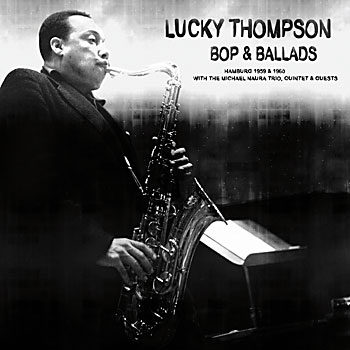
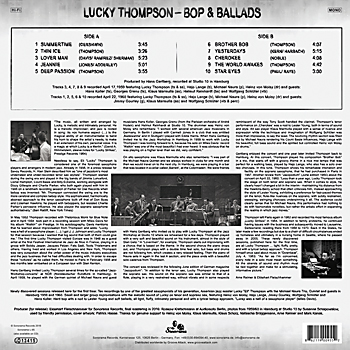
Track
Composer
Time
01
Summertime
Gershwin
3:45
02
Thin Ice
Thompson
3:26
03
Lover Man
Davis/ Ramirez/ Sherman
5:23
04
Jeannie
Jones/ Adderley
5:01
05
Deep Passion
Thompson
3:55
06
Brother Bob
Thompson
4:07
07
Yesterdays
Kern/ Harbach
5:15
08
Cherokee
Noble
4:08
09
The World Awakes
Thompson
4:42
10
Star Eyes
Paul/ Raye
3:00
Produced by Hans Gertberg
Tracks 3, 4, 7, 8 & 9 recorded April 17,1959 at Studio 10 in Hamburg
featuring Lucky Thompson (ts & ss), Hajo Lange (b), Michael Naura (p), Heinz von Moisy (dr) and guests:
Hans Koller (ts), Georges Grenu (ts), Klaus Marmulla (as), Helmut Reinhardt (bs) and Wolfgang Schlüter (vib)
Tracks 1, 2, 5, 6 & 10 recorded April 22, 1960 at Studio 10 in Hamburg
featuring Lucky Thompson (ts & ss), Hajo Lange (b), Michael Naura (p), Heinz von Moisy (dr) and guests:
Jimmy Gourley (g), Klaus Marmulla (as) and Wolfgang Schlüter (vib & perc)
CD & LP: Sonorama C-95/ L-95 (Release Date: 10.06.2016)
“The music, all written and arranged by Lucky, is melodic and intimately personal.
He is a melodic improviser; and jazz is rooted in song: its vox humana aspect (…) is t
he magical ability of an instrumentalist to bend his horn to shape the artist`s needs,
to make it an extension of his own, personal voice. It is a magic at which Lucky is a Merlin.”
(David A. Himmelstein, sleeve notes for “Lucky Strikes”, Prestige Records 1964)
Tracks 3, 4, 7, 8 & 9 recorded April 17,1959 at Studio 10 in Hamburg
featuring Lucky Thompson (ts & ss), Hajo Lange (b), Michael Naura (p), Heinz von Moisy (dr) and guests:
Hans Koller (ts), Georges Grenu (ts), Klaus Marmulla (as), Helmut Reinhardt (bs) and Wolfgang Schlüter (vib)
Tracks 1, 2, 5, 6 & 10 recorded April 22, 1960 at Studio 10 in Hamburg
featuring Lucky Thompson (ts & ss), Hajo Lange (b), Michael Naura (p), Heinz von Moisy (dr) and guests:
Jimmy Gourley (g), Klaus Marmulla (as) and Wolfgang Schlüter (vib & perc)
CD & LP: Sonorama C-95/ L-95 (Release Date: 10.06.2016)
“The music, all written and arranged by Lucky, is melodic and intimately personal.
He is a melodic improviser; and jazz is rooted in song: its vox humana aspect (…) is t
he magical ability of an instrumentalist to bend his horn to shape the artist`s needs,
to make it an extension of his own, personal voice. It is a magic at which Lucky is a Merlin.”
(David A. Himmelstein, sleeve notes for “Lucky Strikes”, Prestige Records 1964)
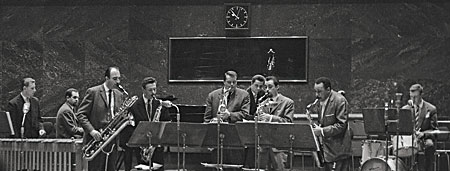
In May 1952 Thompson recorded with Thelonious Monk for Blue Note and in April 1954 took part in a recording session with Miles Davis for his album “Walkin’” on Prestige. In his autobiography, Davis mentions that he learned about improvisation from Thompson and adds: “Lucky was a hell of a saxophone player. (…). I got J. J. Johnson and Lucky Thompson for that session because I wanted that big sound that both of them could give me.” The first time Lucky Thompson visited Europe was in 1948 as a guest artist at the first Festival International de Jazz de Nice in France, playing in a group with Bobby Jasper, Jacques Pelzer, Fats Sadi, Toots Thielemans and others. Having lived and worked in Los Angeles and New York, Thompson was very outspoken about the unfair power of the music industry executives and the jazz business that he had difficulties dealing with. In order to escape these “vultures” as he called them, he moved to Paris in February 1956 and two months later embarked on a European tour with Stan Kenton.
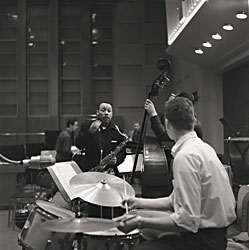
On alto saxophone was Klaus Marmulla who also remembers: “I was part of the Michael Naura Quintet and we always worked in clubs for one month and then we would travel on to the next city. In Hamburg, we were playing in a bar that was located in a cellar called 'Barrett', at the Colonnaden. We were friends with Hans Gertberg who invited us to play with Lucky Thompson at the Jazz Workshop at Studio 10 where we rehearsed for a few days. Thompson played with a very soft and beautiful sound on his instrument, almost in the style of Stan Getz.“ In “Loverman”, for example, Thompson starts out improvising with a chorus that is based on the theme. In the second chorus the piano drops out, and Thompson plays with a double time feel solo, but bass and drums are not following him, which creates a very relaxed feeling. Then the piano of Naura sets in again in the last A section, and the piece ends with a beautiful solo cadenza from Thompson.
The concert was reviewed in the following June edition of German magazine “Jazzpodium”: ”In addition to the tenor sax, Lucky Thompson also played the soprano sax. His sound on the soprano sax was similar to that of a flute, playing in a very restrained way, without vibrato and in some respects reminiscent of the way Tony Scott handled the clarinet. Thompson’s tenor performance on 'Cherokee' was a nod to Lester Young, both in terms of sound and style. Alt sax player Klaus Marmulla played with a sense of nuance and expression while the technique and imagination of Wolfgang Schlüter was more than impressive, to say the least. The bouncing rhythm section was filled out by Michael Naura rendering his Count Basie influences, Hajo Lange with his beautiful, full bass sound and the spirited but controlled Heinz von Moisy on drums.“
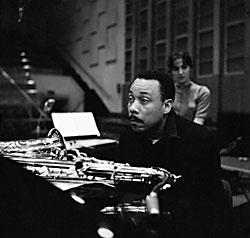
Thompson left Paris again in 1962 and recorded his most famous album "Lucky Strikes" in 1964. In addition to family problems, he continued having issues with the business and subsequently moved to Lausanne, Switzerland, residing there from 1968 to 1970. Back in the States, he later made a few recordings but due to a chain of difficult circumstances ended up homeless and ultimately in a nursing home in Seattle, where he passed away in 2005. These newly discovered sessions, published here for the first time, are all Lucky Thompson … light, fluffy, pretty, and with a lyrical bebop approach. Thompson himself once said about music in “Downbeat”, July 4, 1963: “As far as I’m concerned, every note in a solo must mean something. All the strands of sound and rhythm must be tied together and make for a stimulating, informative picture.“
Arne Reimer & Ekkehart Fleischhammer
Producer (for release): Ekkehart Fleischhammer for Sonorama Records, final mastering in 2016:
Roskow Kretschmann at Audiomoto Berlin, photos by Susanne Schapowalow, used by friendly permission,
sleeve notes: Arne Reimer & Ekkehart Fleischhammer, cover artwork: Patrick Haase.
Thanks for genuine support to Heinz von Moisy, Klaus Marmulla, Klaus Scholz,
Natascha Brüggemann, Arne Reimer and Mark Kanak.
